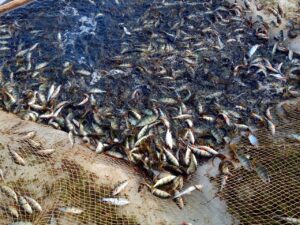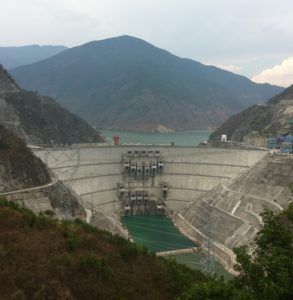Executive Summary
Seafood accounts for more than $140 billion in trade each year.1The Role of the Seafood Supply Chain in Sustainable Fisheries,” The Pew Charitable Trusts, May 3, 2022, https://www.pewtrusts.o rg/en/research-and-analysis/articles/2021/04/13/the-role-of-the-seafood-supply-chain-in-sustainable-fisheries. Commercial fishing is big business, with a complex global seafood supply chain and over 59 million people working on vessels to support it.2The Stimson Center, “Shining a Light: The Need for Transparency across Distant Water Fishing,” Sally Yozell & Amanda Shaver, (2019). https://www.stimson.org/2019/shining-light-need-transparency-across-distant-water-fishing/. The demand for seafood is greater than ever; in 2022, the United States imported 340,000 metric tons of seafood, valued at just over $30 billion.3United States Department of Agriculture, “Seafood Market Update,” Shinsuke Kitada (Tokyo, 2023). https://apps.fas.usda.gov/newgainapi/api/Report/DownloadReportByFileName?fileName=Seafood%20Market%20Update_Osaka%20ATO_Japan_JA2023-0020.pdf. This accounts for approximately 85% of all seafood consumed in the U.S.4Oceana, “U.S. Seafood Demand Drives Illegal Fishing Around the World, Says Oceana Report.” February 1, 2022, https://usa.oceana.org/press-releases/u-s-seafood-demand-drives-illegal-fishing-around-the-world-says-oceana-report/. Seventy-two percent of U.S. consumers support increasing the traceability of seafood, defined as the ability to track seafood throughout its journey in the supply chain.5Morning Consult. “Results for 2022 Traceability Poll: Prepared for Walton Family Foundation,” (2022). https://8ce82b94a8c4fdc3ea6d-b1d233e3bc3cb10858bea65ff05e18f2.ssl.cf2.rackcdn.com/8d/17/493eff174407860f4954f92a927c/2205160-wff-traceability-memo.pdf. However, the complexities of the seafood supply chain, coupled with the subversive nature of illegal, unreported, and unregulated (IUU) fishing makes accurate, real time, and effective seafood traceability difficult and expensive. The International Trade Commission estimated that $2.4 billion worth of illegally harvested seafood products entered the U.S. market in 2019 alone.6United States International Trade Commission, “Seafood Obtained via Illegal, Unreported, and Unregulated Fishing: U.S. Imports and Economic Impact on U.S. Commercial Fisheries,” Renee Berry et al., (Washington, 2021). https://www.usitc.gov/publications/332/pub5168.pdf.
To better understand this challenge, as well as the complexities of the U.S. seafood trade tracking process, the Stimson Center performed desk research and conducted interviews with leading U.S. government experts from eight federal agencies tasked with addressing the multifaceted problem of IUU fishing. Interviews were conducted on deep background with individuals familiar with the existing suite of enforcement tools, U.S. government laws and policies on human rights and labor standards, diplomacy efforts, sustainable fisheries management, and imports and trade in general. The objective of this report is to clarify where the federal government’s vision for seafood trade management and programming in practice are aligned, identify unnecessary duplication, and highlight where gaps exist.
Throughout the research and interview process, several foundational elements of a successful seafood trade system were raised: flexible, real time, actionable, and interoperable. As interviews revealed, there are opportunities that exist now that can begin transforming the existing suite of piecemeal programming into a broader, more cohesive, and holistic vision for seafood traceability in the United States. The report offers nine actionable recommendations for the U.S. government to achieve a holistic, integrated seafood traceability system.
Notes
- 1The Role of the Seafood Supply Chain in Sustainable Fisheries,” The Pew Charitable Trusts, May 3, 2022, https://www.pewtrusts.o rg/en/research-and-analysis/articles/2021/04/13/the-role-of-the-seafood-supply-chain-in-sustainable-fisheries.
- 2The Stimson Center, “Shining a Light: The Need for Transparency across Distant Water Fishing,” Sally Yozell & Amanda Shaver, (2019). https://www.stimson.org/2019/shining-light-need-transparency-across-distant-water-fishing/.
- 3United States Department of Agriculture, “Seafood Market Update,” Shinsuke Kitada (Tokyo, 2023). https://apps.fas.usda.gov/newgainapi/api/Report/DownloadReportByFileName?fileName=Seafood%20Market%20Update_Osaka%20ATO_Japan_JA2023-0020.pdf.
- 4Oceana, “U.S. Seafood Demand Drives Illegal Fishing Around the World, Says Oceana Report.” February 1, 2022, https://usa.oceana.org/press-releases/u-s-seafood-demand-drives-illegal-fishing-around-the-world-says-oceana-report/.
- 5Morning Consult. “Results for 2022 Traceability Poll: Prepared for Walton Family Foundation,” (2022). https://8ce82b94a8c4fdc3ea6d-b1d233e3bc3cb10858bea65ff05e18f2.ssl.cf2.rackcdn.com/8d/17/493eff174407860f4954f92a927c/2205160-wff-traceability-memo.pdf.
- 6United States International Trade Commission, “Seafood Obtained via Illegal, Unreported, and Unregulated Fishing: U.S. Imports and Economic Impact on U.S. Commercial Fisheries,” Renee Berry et al., (Washington, 2021). https://www.usitc.gov/publications/332/pub5168.pdf.




